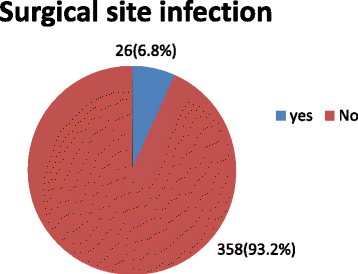Surgical site infection and its associated factors following cesarean section: a cross sectional study from a public hospital in Ethiopia
- PMID: 28616079
- PMCID: PMC5469177
- DOI: 10.1186/s13037-017-0131-3
Surgical site infection and its associated factors following cesarean section: a cross sectional study from a public hospital in Ethiopia
Abstract
Background: A cesarean section is a surgical procedure in which incisions are made through a woman's abdomen and uterus to deliver her baby. Surgical site infections are a common surgical complication among patients delivered with cesarean section. Further it caused to increase maternal morbidity, stay of hospital and the cost of treatment.
Methods: Hospital based cross-sectional study was conducted to assess the magnitude of surgical site infection following cesarean Site Infections and its associated factors at Lemlem Karl hospital July 1, 2013 to June 30, 2016. Retrospective card review was done on 384 women who gave birth via cesarean section at Lemlem Karl hospital from July 1, 2013 to June 30, 2016. Systematic sampling technique was used to select patient medical cards. The data were entered by Epi info version 7.2 then analyzed using Statistical Package for Social Sciences windows version 20. Both bivariate and multivariate logistic regression was done to test association between predictors and dependent variables. P value of < 0.05 was considered to declare the presence of statistically significantly association.
Results: Among 384 women who performed cesarean section, the magnitude of surgical site infection following cesarean section Infection was 6.8%. The identified independent risk factors for surgical site infections were the duration of labor AOR=3.48; 95%CI (1.25, 9.68), rupture of membrane prior to cesarean section AOR=3.678; 95%CI (1.13, 11.96) and the abdominal midline incision (AOR=5.733; 95%CI (2.05, 16.00).
Conclusions: The magnitude of surgical site infection following cesarean section is low compare to other previous studies. The independent associated factors for surgical site infection after cesarean section in this study: Membranes rupture prior to cesarean section, duration of labor and sub umbilical abdominal incision. In addition to ensuring sterile environment and aseptic surgeries, use of WHO surgical safety checklist would appear to be a very important intervention to reduce surgical site infections.
Keywords: Surgical site infection; cesarean section.
Figures
Similar articles
-
Post-cesarean section surgical site infection and associated factors in East Gojjam zone primary hospitals, Amhara region, North West Ethiopia, 2020.PLoS One. 2021 Dec 31;16(12):e0261951. doi: 10.1371/journal.pone.0261951. eCollection 2021. PLoS One. 2021. PMID: 34972176 Free PMC article.
-
Magnitude and determinants of surgical site infecion among women underwent cesarean section in Ayder comprehensive specialized hospital Mekelle City, Tigray region, Northern Ethiopia, 2016.BMC Pregnancy Childbirth. 2018 Dec 12;18(1):489. doi: 10.1186/s12884-018-2075-8. BMC Pregnancy Childbirth. 2018. PMID: 30541473 Free PMC article.
-
Surgical site infection and its associated factors following cesarean section in Ethiopia: a cross-sectional study.BMC Res Notes. 2019 May 27;12(1):288. doi: 10.1186/s13104-019-4325-x. BMC Res Notes. 2019. PMID: 31133045 Free PMC article.
-
The incidence of surgical site infection and its predictors among women delivered via cesarean sections in Ethiopia: a systematic review and meta-analysis.Front Med (Lausanne). 2024 Apr 25;11:1395158. doi: 10.3389/fmed.2024.1395158. eCollection 2024. Front Med (Lausanne). 2024. PMID: 38725468 Free PMC article.
-
Delivery for women with a previous cesarean: guidelines for clinical practice from the French College of Gynecologists and Obstetricians (CNGOF).Eur J Obstet Gynecol Reprod Biol. 2013 Sep;170(1):25-32. doi: 10.1016/j.ejogrb.2013.05.015. Epub 2013 Jun 28. Eur J Obstet Gynecol Reprod Biol. 2013. PMID: 23810846 Review.
Cited by
-
Prevalence and root causes of surgical site infection among women undergoing caesarean section in Ethiopia: a systematic review and meta-analysis.Patient Saf Surg. 2019 Oct 28;13:34. doi: 10.1186/s13037-019-0212-6. eCollection 2019. Patient Saf Surg. 2019. PMID: 31673291 Free PMC article.
-
A systematic review of healthcare-associated infections in Africa: An antimicrobial resistance perspective.Afr J Lab Med. 2018 Dec 6;7(2):796. doi: 10.4102/ajlm.v7i2.796. eCollection 2018. Afr J Lab Med. 2018. PMID: 30568902 Free PMC article. Review.
-
Preoperative anemia and associated factors in women undergoing cesarean section at a comprehensive specialized referral hospital in Ethiopia.Front Med (Lausanne). 2023 Apr 4;10:1056001. doi: 10.3389/fmed.2023.1056001. eCollection 2023. Front Med (Lausanne). 2023. PMID: 37081836 Free PMC article.
-
Prevalence and factors associated with surgical site infections among mothers after cesarean section at Mbarara Regional Referral Hospital, Uganda: an observational retrospective study.Ther Adv Infect Dis. 2024 Oct 9;11:20499361241286838. doi: 10.1177/20499361241286838. eCollection 2024 Jan-Dec. Ther Adv Infect Dis. 2024. PMID: 39398974 Free PMC article.
-
Risk factors for surgical site infection after cesarean delivery in a rural area in China: A case-controlled study.Ann Med Surg (Lond). 2021 Nov 25;72:103110. doi: 10.1016/j.amsu.2021.103110. eCollection 2021 Dec. Ann Med Surg (Lond). 2021. PMID: 34876985 Free PMC article.
References
-
- Research, D.o.R.H.a. and W.H. Organization. WHO Statement on cesarean section Rates. 2015 http://www.who.int/mediacentre/news/releases/2015/cesarean-sections/en/.
-
- ACOG Antimicrobial prophylaxis for cesarean delivery: Timing of administration. Committee Opinion. Obstet Gynecol. 2010;465:791–2. - PubMed
-
- John J. Post-operative morbidity following cesarean delivery. J Hospital Infect. 1995;22:1035–42.
LinkOut - more resources
Full Text Sources
Other Literature Sources


